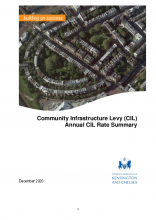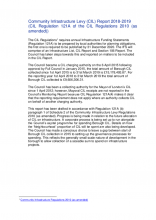Community Infrastructure Levy (CIL)
What is Community Infrastructure Levy?
The Community Infrastructure Levy (CIL) is a planning charge. It was introduced by the Planning Act 2008 as a tool for local authorities in England and Wales to help deliver infrastructure to support the development of their area.
CIL runs alongside Section 106 Agreements.
Neighbourhood CIL
A portion of the CIL is to be spent on local priorities - this is called Neighbourhood CIL. Please see the Neighbourhood CIL page.
Borough CIL
The requirement for a CIL Regulation 123 list has been removed following the enactment of the new CIL Regulations 2019 on 1 September 2019.
Therefore, the CIL Regulation 123 list is now to be used as an informative document on how infrastructure will be or may be funded in whole or part through CIL and section 106 planning obligations. The regulation 123 list has been replaced by the Infrastructure Funding Statement.
Annual CIL Rate Summary
The Annual CIL Rate Summary sets out the CIL rates (adjusted for inflation) that planning permissions granted from 1 January 2024 to 31 December 2024 will be liable to pay:
- Annual CIL Rate Summary 2024
-
In accordance with Regulation 121C of the Community Infrastructure Levy (CIL) Regulations 2010 as amended, the Royal Borough of Kensington and Chelsea is issuing this Annual CIL Rate Summary effective from 1 January 2024 until 31 December 2024. This annual CIL rate summary, published in November 2023, contains the rates for CIL liable development across the Borough for the calendar year 2024. Therefore, any CIL liable planning applications approved between 1st January 2024 and 31st December 2024 will have the indexation rate applied in accordance with the below.
Regulation Reference Requirement Annual CIL Rate Summary 2023 121C(a) state the name of the charging authority (A) to which it relates Royal Borough of Kensington and Chelsea 121C(b) state the year, YN, to which it relates 1 January 2024 to 31 December 2024 121C(c) state the date when each charging schedule and revised charging schedule, issued by A, took effect 6 April 2015 121C(d) specify each of the rates, taken from the charging schedule, at which CIL is chargeable in A’s area, together with a description of the development to which the rate applies See Adopted CIL Charging Schedule (6 April 2015) table 121C(e) specify, for each rate (R) -
(i) the index figure for the calendar year in which the charging schedule containing rate R took effect (as determined in accordance with paragraph 1(5) of Schedule 1);
(ii) the index figure for the calendar year YN (as determined in accordance with paragraph 1(5) of Schedule 1);
(iii) the indexed rate calculated by applying the following formula—(R x ly) / lc
(i) RICS All in Tender Index Price 1 November 2014: 259
(ii) BCIS CIL Index for 1 January 2024 to December 2024: 381
(iii) See Indexed CIL Rates for Calendar Year 2024 table121C(f) where A’s area is in Greater London and the Mayor has a charging schedule in effect which applies in all or part of A’s area, include a statement explaining that the Mayor also charges CIL in relation to all or part of the area. The Mayor of London has a CIL charging schedule in effect which applies to all planning permissions in London, including Kensington and Chelsea.
View this on the TFL websiteTable 1. Adopted CIL Charging Schedule (6 April 2015) Use
Zone
Residential
(C3 & short term lets)
Extra Care Housing Hotels Student Accommodation Industrial / Warehousing Offices Retail Uses Uses that fall within previous D1 and D2 Use Classes All Other Uses Zone A £750 £510 £160
(all zones)£125
(all zones)Nil
(all zones)Zone B £590 £230 Zone C £430 £300 Zone D £270 £160 Zone E £190 Nil Zone F £110 Nil Zone G
(Earl’s Court)Nil
(all uses)Zone H
(Kensal Strategic Site)Nil
(all uses)Table 2. Indexed CIL Rates for Calendar Year 2024 Use
Zone
Residential
(C3 & short term lets)
Extra Care Housing Hotels Student Accommodation Industrial / Warehousing Offices Retail Uses Uses that fall within previous D1 and D2 Use Classes All Other Uses Zone A £1,103.28 £750.23 £235.37
(all zones)£183.88
(all zones)Nil
(all zones)Zone B £867.92 £338.34 Zone C £632.55 £441.31 Zone D £397.18 £235.37 Zone E £279.50 Nil Zone F £161.81 Nil Zone G
(Earl’s Court)Nil
(all uses)Zone H
(Kensal Strategic Site)Nil
(all uses)The RBKC CIL Zones are contained in the Borough CIL Charging Schedule.
- Annual CIL Rate Summary 2023
-
In accordance with Regulation 121C of the Community Infrastructure Levy (CIL) Regulations 2010 as amended, the Royal Borough of Kensington and Chelsea is issuing this Annual CIL Rate Summary effective from 1 January 2023 until 31 December 2023. This annual CIL rate summary, published in December 2022, contains the rates for CIL liable development across the Borough for the calendar year 2023. Therefore, any CIL liable planning applications approved between 1st January 2023 and 31st December 2023 will have the indexation rate applied in accordance with the below.
Regulation Reference Requirement Annual CIL Rate Summary 2023 121C(a) state the name of the charging authority (A) to which it relates Royal Borough of Kensington and Chelsea 121C(b) state the year, YN, to which it relates 1 January 2023 to 31 December 2023 121C(c) state the date when each charging schedule and revised charging schedule, issued by A, took effect 6 April 2015 121C(d) specify each of the rates, taken from the charging schedule, at which CIL is chargeable in A’s area, together with a description of the development to which the rate applies See Adopted CIL Charging Schedule (6 April 2015) table 1 121C(e) specify, for each rate (R) -
(i) the index figure for the calendar year in which the charging schedule containing rate R took effect (as determined in accordance with paragraph 1(5) of Schedule 1);
(ii) the index figure for the calendar year YN (as determined in accordance with paragraph 1(5) of Schedule 1);
(iii) the indexed rate calculated by applying the following formula—(R x ly) / lc
(i) RICS All in Tender Index Price 1 November 2014: 259
(ii) BCIS CIL Index for 1 January 2023 to December 2023: 355
(iii) See Indexed CIL Rates for Calendar Year 2023 table 2
121C(f) where A’s area is in Greater London and the Mayor has a charging schedule in effect which applies in all or part of A’s area, include a statement explaining that the Mayor also charges CIL in relation to all or part of the area. The Mayor of London has a CIL charging schedule in effect which applies to all planning permissions in London, including Kensington and Chelsea.
Adopted CIL Charging Schedule (6 April 2015)
Zone Residential
(C3 & short term lets)Extra Care Housing Hotels Student Accommodation Industrial / Warehousing, Offices (B1), Retails Uses, D1 and D2 uses, All other uses Zone A £750 £510 £160 (all zones) £125 (all zones) Nil (all zones) Zone B £590 £230 Zone C £430 £300 Zone D £270 £160 Zone E £190 Nil Zone F £110 Nil Zone G (Earl’s Court) Nill (all uses) Zone H (Kensal Strategic Site) Nill (all uses) Indexed CIL Rates for Calendar Year 2023
The RBKC CIL Zones are contained the Borough CIL Charging Schedule.Zone Residential
(C3 & short term lets)Extra Care Housing Hotels Student Accommodation Industrial / Warehousing, Offices (B1), Retails Uses, D1 and D2 uses, All other uses Zone A £1,027.99 £699.03 £219.31 (all zones) £171.33
(all zones)Nil (all zones) Zone B £808.69 £315.25 Zone C £599.38 £411.20 Zone D £370.08 £219.31 Zone E £260.42 Nil Zone F £150.77 Nil Zone G (Earl’s Court) Nill (all uses) Zone H (Kensal Strategic Site) Nill (all uses) - Past Annual CIL Rate Summaries
Infrastructure Funding Statement
The Infrastructure Funding Statement (IFS) summarises the amount of developer contributions received, allocated and spent. This new reporting requirement was introduced as part of the recently amended CIL regulations in 2019. The introduction of this Infrastructure Funding Statement now means that monitoring around CIL and section 106 will now be found in the IFS instead of the Council’s Monitoring report.
- Previous Infrastructure Funding Statements and CIL Reporting
-
CIL calculator
You can use the online CIL calculator to help you estimate your potential CIL liabilities:
Borough CIL charging zone maps
Use these maps to find out about CIL charging zone boundaries in the borough:
Mayoral CIL
The Mayor’s Community Infrastructure Levy (MCIL1) was introduced in 2012 to help finance Crossrail. In February 2019 the Mayor replaced it with a new charging schedule (MCIL2).
Mayoral CIL 1 (MCIL1) applies to CIL liable developments permitted before 1 April 2019.
Mayoral CIL 2 (MCIL2) applies to CIL liable developments permitted on or after the 1 April 2019.
MCIL2
Copies of the adopted MCIL2 Charging Schedule are available by visiting the Greater London Authority Website and viewing the files:
This table details MCIL2 rates (including indexation for calendar year 2021) in the Royal Borough of Kensington and Chelsea:
| Use | Rate |
|---|---|
|
For all development except for office, retail and hotel in Central London and for health and education in all of Greater London (Royal Borough of Kensington and Chelsea) |
£80.73/m2 |
|
Office use in Central London (see Central London MCIL2 charging area map contained in the MCIL2 charging Schedule) |
£186.68/m2 |
|
Retail use in Central London (see Central London MCIL2 charging area map contained in the MCIL2 charging Schedule) |
£166.50/m2 |
|
Hotel use in Central London (see Central London MCIL2 charging area map contained in the MCIL2 charging Schedule) |
£141.27m2 |
|
Development used wholly or mainly for the provision of any medical or health services except the use of premises attached to the residence of the consultant or practitioner |
nil |
|
Development used wholly or mainly for the provision of education as a school or college under the Education Acts or as an institution of higher education |
nil |
MCIL1
MCIL1 still applies to developments first permitted before the 1 April 2019. This table details MCIL1 rates (including indexation for calendar year 2021) in the Royal Borough of Kensington and Chelsea:
|
Use |
Rate |
|
Development used wholly or mainly for the provision of any medical or health services except the use of premises attached to the residence of the consultant or practitioner |
Nil |
|
Development used wholly or mainly for the provision of education as a school or college under the Education Acts or as an institution of higher education |
Nil |
|
All other uses (Royal Borough of Kensington and Chelsea) |
£74.66/m2 |
Further information on the Mayor of London’s CIL is available from the London Assembly's website and visiting the links:
Supplementary planning guidance (SPG)
CalculatingCIL
Payable CIL developments
CIL may be payable on developments which creates net additional floorspace, where the Gross Internal Area (GIA) of new build exceeds 100m2. That limit does not apply to new dwellings, and the charge can be levied on a single house or flat of any size, unless it is built by a ‘self builder’.
Non-payable CIL developments
- Development of less than 100m2 – unless this is a whole dwelling, in which case, the levy is payable.
- Houses, flats, residential annexes and residential extensions which are built by ‘self-builders’.
- Social housing that meets the relief criteria.
- Charitable development that meets the relief criteria.
- Buildings into which people do not normally go.
- Buildings into which people go only intermittently for the purpose of inspecting or maintaining fixed plant or machinery.
- Structures which are not buildings, such as pylons and wind turbines.
- Specified types of development which local authorities have decided should be a ‘zero’ rate and specified as such in their charging schedules.
- Vacant buildings brought back into the same use.
Exemptions
There is no CIL charge on calculated liability of less than £50.
Mezzanine floors of less than 200m2 which are added to an existing building are not liable for the CIL unless they form part of a wider planning permission that provides other works.
CIL forms and procedures
If you are liable for CIL you have important statutory responsibilities. Read more:
There are six key steps:
Step 1: submit a planning application using the CIL form calculator
Note 24 of the local validation checklist covers planning contributions. It includes a requirement to submit a CIL form accompanied by a completed CIL Calculator with a planning application where there is any net increase in floorspace or where all of the existing floorspace is ‘vacant’.
Find out how to submit an application.
The CIL form and CIL form guidance are available on the Planning Portal CIL page.
Step 2: planning permission and the CIL liability notice
CIL is charged on new development. Normally this requires planning permission from the Council, the Planning Inspectorate or the Secretary of State on appeal. CIL may also be payable on permitted development.
Normally, shortly after planning permission is granted, the Council will serve a CIL liability notice, clarifying the amount of CIL that is liable for that development (excluding indexation for inflation).
Step 3: who is liable for CIL and the assumption of liability form
Landowners are ultimately liable to pay CIL, but anyone involved in a development may take on the liability to pay.
The party intending to assume liability for CIL must submit an assumption of liability form to the Council before the development commences.
The following documents are available on the Planning Portal CIL page:
- CIL Form 2: Assumption of liability
- CIL Form 3: Withdrawal of assumption of liability
- CIL Form 4: Transfer of assumed liability
This step could be undertaken alongside any earlier steps.
Step 4: claiming exemption or relief from CIL
Use the CIL Calculator to determine whether the development is eligible for exemption or relief from CIL.
Complete the appropriate forms if you want to claim for exemption or relief. We'll notify you of our decision before your development starts.
The following documents are available on the Planning Portal CIL page:
- CIL Form 7: Self build exemption claim form: Part 1
- CIL Form 7: Self build exemption claim form: Part 2
- CIL Form 8: Self Build residential annex claim form
- CIL Form 9: Self build residential extension claim form
- CIL Form 10: Charitable and/or Social Housing Relief Claim
This step could be undertaken alongside any earlier steps.
Step 5: commencing development
You need to submit a CIL commencement notice confirming your development start date before the development commences.
- CIL Form 6: Commencement notice is available on the Planning Portal CIL page.
Shortly after your development start date we will serve a CIL demand notice. This details the amount of CIL that is payable (including indexation for inflation).
Step 6: paying CIL
CIL is usually payable within 60 days of the development commencing or the CIL demand notice. It may be possible for you to pay in instalments if our instalments policy allows for this. This came into effect on 8 June 2018.
Make your payment through Accounts receivable.
Useful information
- How to make an appeal
- Making a CIL enforcement appeal
- CIL Form 5: Notice of chargeable development is available on the Planning Portal CIL page.
Contact us
Planning Policy
Planning and Borough Development
Town Hall
Hornton Street
W8 7NX
Tel: 020 7361 3012
Email: [email protected]
Page updated: May 2018
Last updated: 16 January 2024








